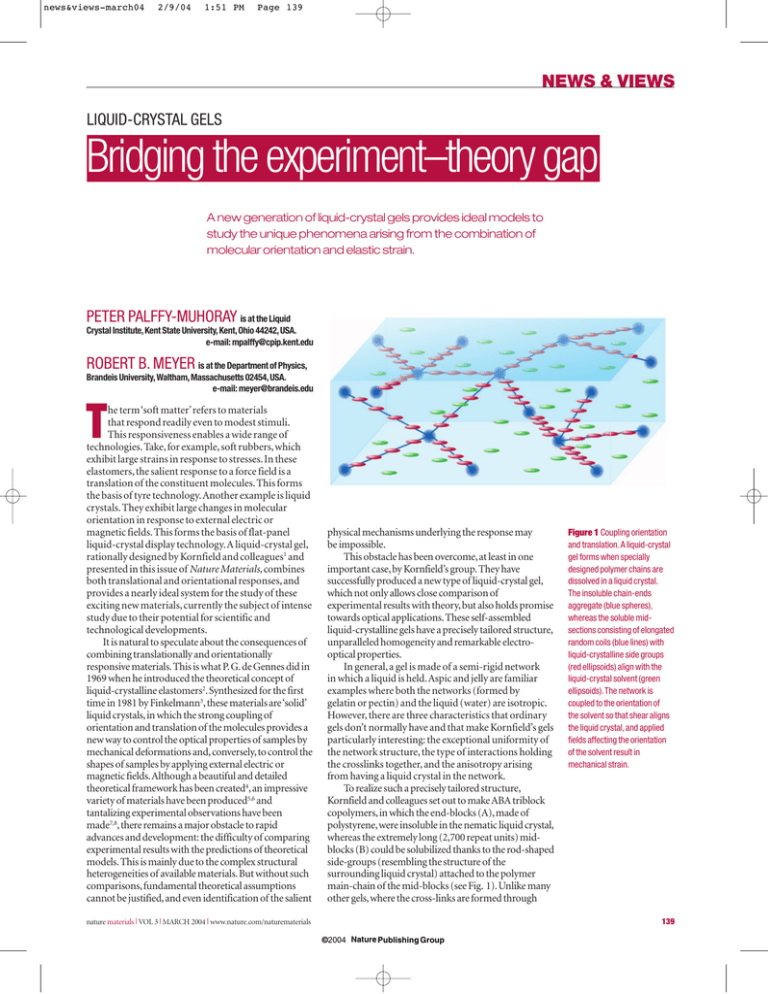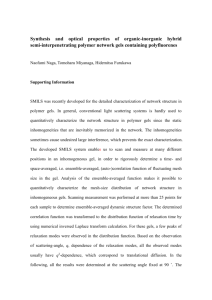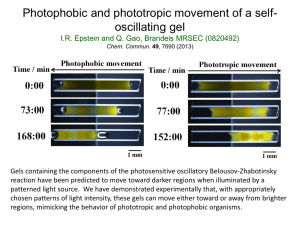NEWS & VIEWS PETER PALFFY-MUHORAY
advertisement

news&views-march04 2/9/04 1:51 PM Page 139 NEWS & VIEWS LIQUID-CRYSTAL GELS Bridging the experiment–theory gap A new generation of liquid-crystal gels provides ideal models to study the unique phenomena arising from the combination of molecular orientation and elastic strain. PETER PALFFY-MUHORAY is at the Liquid Crystal Institute, Kent State University, Kent, Ohio 44242, USA. e-mail: mpalffy@cpip.kent.edu ROBERT B. MEYER is at the Department of Physics, Brandeis University, Waltham, Massachusetts 02454, USA. e-mail: meyer@brandeis.edu T he term ‘soft matter’refers to materials that respond readily even to modest stimuli. This responsiveness enables a wide range of technologies. Take, for example, soft rubbers, which exhibit large strains in response to stresses. In these elastomers, the salient response to a force field is a translation of the constituent molecules. This forms the basis of tyre technology.Another example is liquid crystals. They exhibit large changes in molecular orientation in response to external electric or magnetic fields. This forms the basis of flat-panel liquid-crystal display technology.A liquid-crystal gel, rationally designed by Kornfield and colleagues1 and presented in this issue of Nature Materials, combines both translational and orientational responses, and provides a nearly ideal system for the study of these exciting new materials, currently the subject of intense study due to their potential for scientific and technological developments. It is natural to speculate about the consequences of combining translationally and orientationally responsive materials. This is what P. G. de Gennes did in 1969 when he introduced the theoretical concept of liquid-crystalline elastomers2. Synthesized for the first time in 1981 by Finkelmann3, these materials are ‘solid’ liquid crystals, in which the strong coupling of orientation and translation of the molecules provides a new way to control the optical properties of samples by mechanical deformations and, conversely, to control the shapes of samples by applying external electric or magnetic fields.Although a beautiful and detailed theoretical framework has been created4, an impressive variety of materials have been produced5,6 and tantalizing experimental observations have been made7,8, there remains a major obstacle to rapid advances and development: the difficulty of comparing experimental results with the predictions of theoretical models. This is mainly due to the complex structural heterogeneities of available materials. But without such comparisons, fundamental theoretical assumptions cannot be justified, and even identification of the salient physical mechanisms underlying the response may be impossible. This obstacle has been overcome, at least in one important case, by Kornfield’s group. They have successfully produced a new type of liquid-crystal gel, which not only allows close comparison of experimental results with theory, but also holds promise towards optical applications. These self-assembled liquid-crystalline gels have a precisely tailored structure, unparalleled homogeneity and remarkable electrooptical properties. In general, a gel is made of a semi-rigid network in which a liquid is held. Aspic and jelly are familiar examples where both the networks (formed by gelatin or pectin) and the liquid (water) are isotropic. However, there are three characteristics that ordinary gels don’t normally have and that make Kornfield’s gels particularly interesting: the exceptional uniformity of the network structure, the type of interactions holding the crosslinks together, and the anisotropy arising from having a liquid crystal in the network. To realize such a precisely tailored structure, Kornfield and colleagues set out to make ABA triblock copolymers, in which the end-blocks (A), made of polystyrene, were insoluble in the nematic liquid crystal, whereas the extremely long (2,700 repeat units) midblocks (B) could be solubilized thanks to the rod-shaped side-groups (resembling the structure of the surrounding liquid crystal) attached to the polymer main-chain of the mid-blocks (see Fig. 1). Unlike many other gels, where the cross-links are formed through nature materials | VOL 3 | MARCH 2004 | www.nature.com/naturematerials Figure 1 Coupling orientation and translation.A liquid-crystal gel forms when specially designed polymer chains are dissolved in a liquid crystal. The insoluble chain-ends aggregate (blue spheres), whereas the soluble midsections consisting of elongated random coils (blue lines) with liquid-crystalline side groups (red ellipsoids) align with the liquid-crystal solvent (green ellipsoids).The network is coupled to the orientation of the solvent so that shear aligns the liquid crystal, and applied fields affecting the orientation of the solvent result in mechanical strain. 139 ©2004 Nature Publishing Group news&views-march04 2/9/04 1:51 PM Page 140 NEWS & VIEWS covalent or hydrogen bonds, the crosslinks in Kornfield’s gels are the result of aggregation of the endblocks (A) due to their poor solubility in the liquidcrystal solvent.An interesting aspect is the ability of the crosslinks to reversibly open and close, allowing the polymer network to reorganize.Although this aspect introduces additional complexity into the modelling, it may be a useful feature in certain applications. As in gelatin gels, the gelation process is thermoreversible. This means that these materials melt to form a viscous fluid at high temperatures, but solidify again to form a gel when the temperature is lowered. But unlike gelatin gels, Kornfield’s gels have the optical properties of doubly refracting crystals, and can be aligned by either magnetic or electric fields or by mechanical shear — giving evidence of the coupling of orientation and translation. The lengths of the polymer chains separating the crosslinks, as well as the crosslink density, are well defined because of the uniform degree of polymerization of the mid-blocks (B). Their unusually high molecular weight allows gels to form even at very low polymer concentrations, allowing realization of gels with a broad range of properties as the concentration is varied. In all materials, homogeneity is a matter of length scale. Kornfield’s gels are homogeneous on length scales above tenths of micrometres, rather than the tens of micrometres of more conventional polymer–liquidcrystal composites. Owing to their uniformity, and to the extraordinary length of their mid-block polymer chains, they conform very closely to theoretical rubber-elastic models that have been developed4. Other materials present more complex behaviour because of their less uniform and less rubber-like structure, making them less useful for fundamental studies, although they have proved fascinating for exploring potential applications. In addition to making possible the much-needed connection between experiment and theory, Kornfield’s gels can also be switched rapidly between optically clear and scattering states, and so may find use in display technology. Extensions of Kornfield’s work will probably involve different liquid crystals as well as other phases. For example, investigating gels with ‘banana shaped’liquid crystals9 might be a fruitful endeavour. References 1. Kempe, M. D., Scruggs, N. R., Verduzco, R., Lal, J. & Kornfield, J. A. Nature Mater. 3, 177–182 (2004). 2. de Gennes, P. G. Phys. Lett. A 28, 725-726 (1969). 3. Finkelmann H., Kock H. & Rehage G. Makromol. Chem. Rapid Commun. 2, 3171– 3173 (1981). 4. Warner, M. & Terentjev, E. M. Liquid Crystal Elastomers (Clarendon, Oxford, 2003). 5. Gebhard, E. & Zentel, R. Macromol. Chem. Phys. 201, 902–922 (2000). 6. Kim, S.-T. & Finkelmann, H. Macromol. Rapid Commun. 22, 429–433 (2001). 7. Lehmann, W., Skupin, H. & Tolksdof, D. et al. Nature 410, 447–450 (2001). 8. Camacho-Lopez, M., Finkelmann, H., Palffy-Muhoray, P. & Shelley, M. Fast liquid crystal elastomer swims into the dark. e-Liq. Cryst. Commun. published online 25 November 2003 (http://e-lc.org). 9. Pelzl, G., Diele, S. & Weissflog, W. Banana-shaped compounds - A new field of liquid crystals. Adv. Mater. 11, 707–724 (1999). MATERIAL WITNESS The case for talking N o one denies that emerging technologies can learn lessons from the fate of genetically modified crops in the UK. But there is no consensus about what those lessons are. Businesses might conclude that it is perilous to introduce new technologies in the face of public ignorance about their scientific basis. Opponents of global capitalism might draw faith in the power of public opinion to oppose commercial interests. The British government shows signs of concluding that sometimes the public simply does not know what is good for it. This divergence of opinion provides one reason why the aims of the Forum for Technology, Citizens and the Market, launched in January by the Royal Society of Arts, Manufactures and Commerce (RSA) in London, are laudable. The forum will seek to encourage dialogue between industries, consumers, governmental bodies and other interested parties as emerging technologies approach the market. One of the current candidates for such treatment is nanotechnology, which some fear might go the way of GM and biotechnology in provoking a collision between public opinion and industrial intentions. Similarly, radiofrequency tagging of products (and perhaps of raw materials) promises consumer benefits, improved security and easy recycling, but carries implications for privacy and surveillance. In this arena, ‘social learning’ seems to be poor among industries, scientists and the public alike. No one learns from past mistakes. Studies have suggested that opposition to GM crops was centred not on a general (mis)understanding of the science, but on the question of public trust in those making the decisions. Yet the scientific community has commonly responded by lamenting the paucity of scientific knowledge in society. Thus scientists have tended to construct ‘deficit’ models to explain resistance to new technologies. Once they argued that the problem was lack of knowledge. Then they asserted that there was poor comprehension of the scientific process — how it deals with issues like uncertainty. Now that seems to be replaced by the perception of a deficit in trust of scientific authorities. In each case, the argument goes, if only the deficit were redressed, the public would welcome the technology with open arms. This is not to deny the importance of good science communication and education. But it is patronizing to public opinion, which may draw on nonscientific (and possibly quite valid) reasons to oppose a new technology. The challenge for projects like the RSA’s is that if the hard questions about public involvement in shaping the technological future are squarely faced, they become dauntingly broad. For example, it’s often argued that a misguided rejection of new technologies stifles wealth creation. But when studies show that above a certain threshold of prosperity, economic growth no longer improves social happiness, the case for wealth creation as an end in itself is no longer self-evident. Better, perhaps, to ground advocacy in terms of demonstrable social benefits — for example, for health or the environment — which will be case-specific. Harder still is the issue of whether there should be a public mandate at all for new technologies, and if so, how it should be identified. Philip Ball nature materials | VOL 3 | MARCH 2004 | www.nature.com/naturematerials 140 ©2004 Nature Publishing Group



